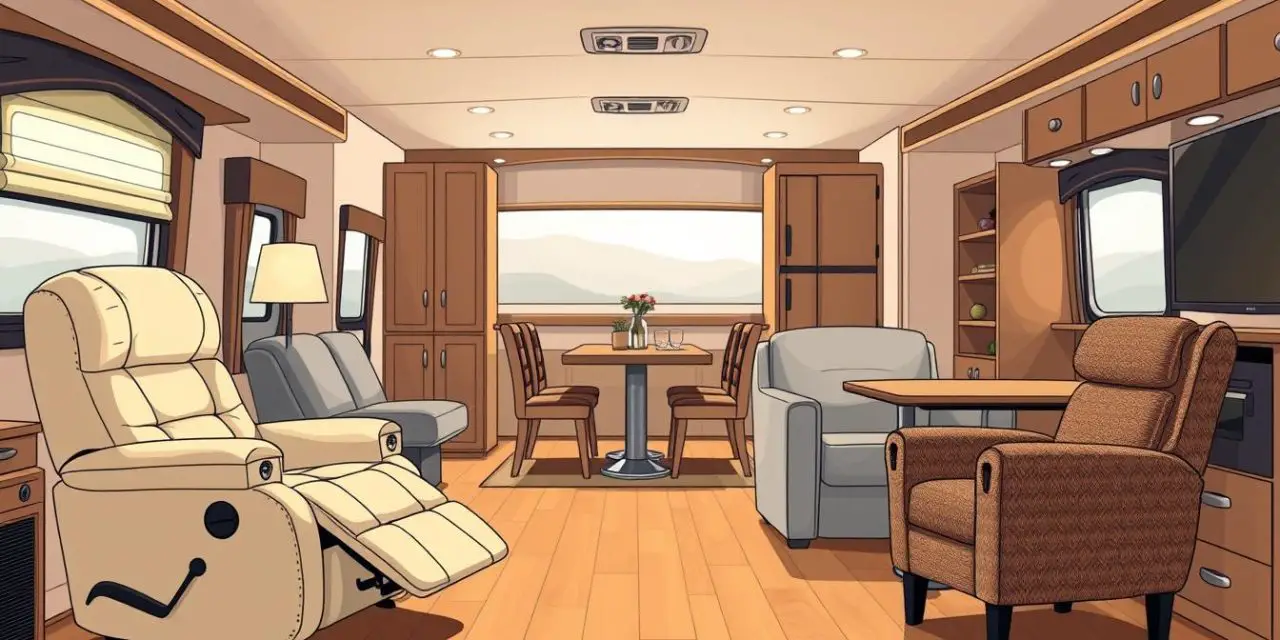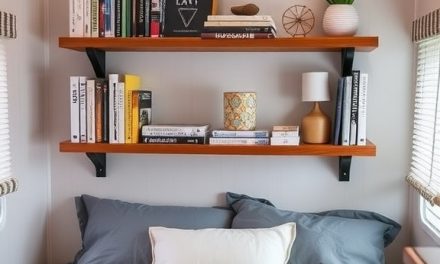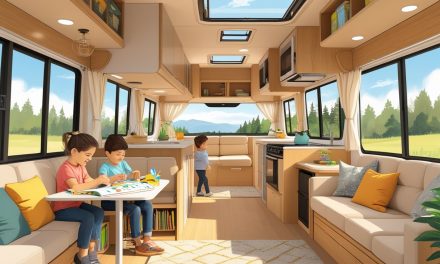Would you like to save this article?
Imagine a recreational vehicle that weighs hundreds of pounds less than its standard counterpart. This significant weight reduction is a major advantage for those seeking a blank canvas for their mobile adventures.
Welcome to your complete guide on acquiring a recreational vehicle with an empty interior. While dealerships typically sell fully furnished models, a furniture-free option is absolutely attainable. This path offers a unique opportunity for personalization.
Many adventurers pursue this route to gain total control over their living space. It allows for a design that perfectly matches individual needs and travel style. This guide will explore the various paths to achieving this goal.
We will cover custom orders from manufacturers, finding used models that have been stripped of their interior furnishings, and even converting cargo trailers. Starting with an empty shell provides unparalleled freedom for your interior design, weight management, and functional layout.
This article will walk you through the entire process. You will learn about the benefits, potential challenges, key planning considerations, and a step-by-step approach to furnishing your personalized home on wheels.
Key Takeaways
- Purchasing an RV without pre-installed furniture is a viable and strategic choice.
- A blank interior allows for complete customization of the layout and design.
- Weight distribution can be optimized for better vehicle performance and fuel efficiency.
- Options include custom factory orders and modifying used or cargo trailers.
- This approach requires careful planning but results in a truly personalized living space.
- Understanding the process helps in navigating dealerships and aftermarket solutions.
Introduction to the Bare RV Lifestyle
Consider the freedom of a travel-ready shell that hasn’t been predetermined by factory layouts. This approach to mobile living represents a growing movement among modern adventurers.
Overview of a Furniture-Free RV
A truly bare recreational vehicle comes as an empty shell with essential systems intact. You’ll find plumbing, electrical wiring, and HVAC components already installed. What’s missing are the standard built-in pieces that typically fill these spaces.
The interior stands completely open, waiting for your personal touch. This blank canvas approach eliminates pre-installed seating, beds, tables, and cabinetry. Every square foot becomes available for your custom design ideas.
Why Consider a Bare RV?
Many travelers choose this path to create a living space that perfectly matches their unique needs. Instead of adapting to a manufacturer’s standard layout, you design from scratch. This method proves ideal for remote workers needing office space or families requiring specific sleeping arrangements.
Starting with an empty interior offers significant financial advantages. You avoid paying for standard furniture that might not suit your lifestyle. Those savings can then fund higher-quality pieces or other vehicle upgrades.
The bare RV way also provides complete control over weight distribution from day one. This strategic approach supports safer towing and better fuel efficiency. Your mobile home becomes a true reflection of your travel vision rather than a compromise.
Creative individuals particularly appreciate this approach. They can implement unconventional design concepts that standard models wouldn’t accommodate. The freedom to select every piece of furniture ensures your space works exactly how you need it to.
Understanding the RV Furniture Replacement Process
Many RV enthusiasts eventually face the decision to upgrade their interior furnishings. This process involves more than just aesthetic updates—it’s about creating a space that truly works for your lifestyle.
Common Reasons for Replacing RV Furniture
After several years of adventures, original pieces often show significant wear. Constant travel creates vibrations that loosen joints and fade fabrics. Sun exposure through windows accelerates this aging process.
Full-time travelers experience faster deterioration. Their furniture sees daily use that standard vacation setups avoid. This makes replacement furniture a practical necessity rather than just a style upgrade.
Changing family needs also drive replacement decisions. Growing families frequently need additional sleeping capacity. Convertible sofas and tri-fold sleepers become essential for hosting guests.
New owners of used rigs often inherit someone else’s design choices. While functionally sound, the style might not match their vision. Personalization becomes a key motivation for replacement.
Key Concerns of RV Owners
Several important things worry owners during this process. Narrow doorways present challenges for bringing in new pieces. Proper measurements become critical before any purchase.
Weight distribution remains a top priority. Uneven loading affects towing safety and fuel efficiency. Securing pieces properly for travel prevents dangerous movement.
Warranty considerations also factor into decisions. Some modifications might void original warranties. Understanding these implications saves headaches down the road.
Even those starting with empty interiors benefit from this knowledge. It helps avoid common pitfalls that lead to premature furniture changes over time.
Can You Buy a RV Without Furniture
For those who envision a unique floor plan that standard models cannot provide, alternative purchasing approaches exist. The answer is definitively yes—acquiring a recreational vehicle without pre-installed furnishings is absolutely achievable through various methods.
Several manufacturers recognize this growing demand and offer “shell” versions of their travel trailers and motorhomes. These models come with essential systems installed but leave the interior space completely open for customization.
Purchasing a used model presents another excellent opportunity. Many owners strip their vehicles before selling, creating a blank canvas for the next adventurer. This approach often provides significant cost savings compared to new purchases.
The conversion of cargo trailers has gained considerable popularity among DIY enthusiasts. These units start as completely empty spaces, offering maximum flexibility for personalized design. Every aspect of the layout becomes your creative project.
Special ordering from manufacturers or working with custom builders may be necessary for some models. This ensures you receive exactly what you want from the beginning. The process requires clear communication about your specific needs.
Remember that selecting all furniture pieces becomes your responsibility with this approach. Each item must meet specific requirements for weight, security, and functionality during travel. Proper planning ensures a safe and comfortable mobile home.
This empty interior provides the unique opportunity to design a living area that perfectly matches your lifestyle. Whether creating a mobile office, family space, or minimalist retreat, the possibilities are truly endless.
Evaluating the Benefits of a DIY RV Interior
The hands-on approach to outfitting your recreational vehicle interior delivers practical benefits that factory installations often overlook. This method transforms your mobile space into a truly personalized environment.
Cost-Effectiveness and Customization
Building your own interior creates significant savings. You can shop sales, repurpose existing items, or construct custom pieces for less than pre-installed options.
Complete customization allows unlimited design ideas. Choose modern minimalist, cozy farmhouse, or vibrant bohemian styles without manufacturer limitations.
Prioritize features that matter most to your lifestyle. Maximize storage, create workspace, or ensure accessibility based on your specific needs.
Balancing Weight and Functionality
Weight management is critical for safe travel. Every pound affects towing stability and fuel efficiency.
A DIY approach gives complete control over weight distribution. You can plan strategically where heavier items go for proper balance.
Choose lightweight materials and multifunctional furniture. Consider inflatable options for guests and fold-down tables instead of permanent fixtures.
| Feature | DIY Approach | Factory Installation |
|---|---|---|
| Cost Control | Shop sales, use repurposed items | Fixed manufacturer pricing |
| Customization | Unlimited design possibilities | Limited standard options |
| Weight Management | Strategic placement from start | Pre-determined distribution |
| Travel Safety | Custom securing methods | Factory-installed anchors |
Planning Your RV Interior Layout
Creating your ideal mobile home starts with one crucial step: understanding your available space. This planning phase determines whether your furnishings will enhance your adventures or create constant frustration.
Proper preparation prevents poor performance, especially when designing compact living areas. Careful measurement and thoughtful layout design save you from costly mistakes.
Assessing Available Space and Measurements
Begin by creating a detailed floor plan of your entire interior. Measure length, width, and height of each area, noting obstacles like wheel wells and slide-out mechanisms.
Assess your space realistically beyond static numbers. Consider movement room for door swings, slide operation, and comfortable passage. Traffic flow matters greatly in limited square footage.
“Measure twice, cut once” applies perfectly to RV furniture selection. Even an inch makes the difference between perfect fit and disappointment.
Take measurements multiple times under different conditions. Check dimensions with slides both in and out if your model has them. This accuracy ensures furniture fits perfectly upon delivery.
Visualize different arrangements using scale drawings or online planning tools. Experiment with layouts virtually before committing. Position sleeping areas for privacy, workspaces near windows, and dining spots accessible from the kitchen.
This strategic approach transforms your empty space into a functional, personalized living environment. Thoughtful planning makes every inch work perfectly for your lifestyle.
Choosing Between RV-Specific and Residential Furniture
Selecting the right furnishings for your recreational vehicle involves a critical decision between specialized and residential options. Each choice carries distinct advantages and challenges that affect your mobile lifestyle.
Understanding RV-Specific Design Considerations
RV-specific furniture is engineered specifically for life on the road. These pieces feature lightweight construction to avoid overburdening your vehicle’s weight capacity.
Compact sizing ensures furniture fits through narrow doors and around tight corners. Built-in storage maximizes limited space efficiently.
Durability is another key advantage. These items withstand constant vibration and travel stresses better than standard home furniture.
Pros and Cons of Residential Furniture in a RV
Residential furniture offers greater style selection and typically lower prices. You can match your personal aesthetic preferences more easily with mainstream home decor.
However, significant drawbacks exist. Standard pieces are heavier, impacting fuel economy and weight ratings. Larger dimensions may not fit through RV doors.
Construction may not withstand travel stresses, requiring more frequent replacement. Security becomes crucial—all furniture must be properly anchored to prevent dangerous shifting.
| Feature | RV-Specific Furniture | Residential Furniture |
|---|---|---|
| Weight | Lightweight construction | Typically heavier |
| Durability | Travel-resistant materials | Standard home use |
| Storage Features | Integrated compartments | Usually separate storage needed |
| Security | Pre-installed anchors | Requires custom securing |
Many adventurers successfully blend both approaches. They choose lighter residential pieces and ensure proper installation. Additional storage solutions may be needed when using home furniture.
Step-by-Step Guide to Removing Existing RV Furniture
The process of transforming your mobile space begins with safely extracting what’s already installed. This crucial first step requires careful planning to avoid unnecessary complications.
Safety and Preparation Tips
Always prioritize safety when removing interior pieces. Wear protective gloves and safety glasses to prevent injuries from sharp edges or flying debris.
Have a helper assist with larger items to avoid strain. Clear the area completely before starting work. Protect floors and walls with moving blankets to prevent scratches.
Document the original setup with photos for reference. This helps during new installation planning. Take your time to avoid causing damage to surrounding surfaces.
| Preparation Step | Purpose | Tools Needed |
|---|---|---|
| Area Clearing | Prevent obstructions | Storage bins |
| Surface Protection | Avoid scratches | Moving blankets |
| Documentation | Reference for installation | Camera/phone |
| Tool Preparation | Efficient removal | Screwdrivers, wrenches |
Check attachment methods before disassembly. Most pieces use bolts through the floor or wall brackets. Some may have hidden staples or adhesive applications.
Measure your door opening before attempting removal. Larger items might require window or windshield removal. This adds considerable time to the project.
Keep warranty implications in mind when working on newer models. Removing original pieces may void certain coverage terms. Consider selling usable removed furniture to recoup costs.
Tools and Techniques for Accurate Measurements
Precision measurement tools transform guesswork into confident furniture selection for your mobile home. Gathering exact dimensions before shopping prevents the disappointment of pieces that don’t fit properly.
Essential equipment includes a 25-foot tape measure for overall dimensions. A laser measuring device helps with hard-to-reach areas and ceiling heights. Don’t forget a notepad for recording numbers and a level to check for floor irregularities.
Start by measuring the entire interior length, width, and height. Then document specific details like alcove depths and corner angles. Note slide-out dimensions when extended and retracted.
The RV door opening typically measures around 26 inches wide. This critical measurement determines what can enter your space. Always verify this dimension before considering larger furniture pieces.
Irregular spaces require special techniques. Use cardboard templates for curved walls or wheel well intrusions. Flexible measuring tools work well for angled corners where standard tapes struggle.
Measure each area multiple times from different angles. Small errors can lead to significant fitting problems. This verification step saves time and money on returns.
Create a comprehensive diagram showing all dimensions, door swings, and outlet locations. This visual reference becomes invaluable when shopping online or in stores.
Remember to measure the entire pathway furniture must travel. Include hallways, turns, and slide-out openings. Choosing pieces that disassemble makes installation easier despite door width limitations.
Strategies for Securing Furniture During Travel
Properly anchoring every piece inside your mobile home is not just a recommendation—it’s a critical safety requirement. The dynamic forces of highway movement create conditions that stationary home furnishings never experience.
Every journey subjects your interior to constant vibrations, sudden bounces, and impact forces. Unsecured items can shift dangerously, affecting vehicle stability and creating potential hazards.
Methods to Bolt Down or Anchor Pieces
Several effective methods ensure your furnishings stay firmly in place. L-brackets provide reliable attachment when secured to both furniture and floor/wall structures.
Heavy-duty bolts through furniture legs offer direct floor connection. Specialized mounting hardware designed for recreational vehicles withstands travel stresses best.
For temporary securing needs, consider heavy-duty velcro straps or ratchet tie-downs. Custom frames can lock pieces in place during movement while allowing removal when parked.
| Securing Method | Best For | Installation Level |
|---|---|---|
| L-Brackets | Permanent installations | Moderate difficulty |
| Heavy-Duty Bolts | Solid wood furniture | Advanced skill needed |
| RV Mounting Hardware | Manufacturer-specific pieces | Easiest installation |
| Ratchet Tie-Downs | Temporary or adjustable needs | Beginner friendly |
Ensuring Even Weight Distribution
Balanced weight placement maintains vehicle stability during travel. Heavier items should be positioned to create equal distribution from front to back and side to side.
Visit truck scales to verify your loaded vehicle stays within weight ratings. Proper balance prevents dangerous sway and improves handling.
Test security before each trip by applying firm pressure to each piece. Regular inspections catch loosened hardware before it causes damage or safety issues.
DIY Tips for Furnishing Your Bare RV
Personalizing your mobile living space doesn’t require extensive construction skills or massive budgets. Creative approaches can transform your interior while keeping expenses reasonable.
Many travelers achieve stunning results through simple upgrades and smart shopping strategies. These methods deliver custom looks without professional installation costs.
Simple Upgrades and Reupholstering Ideas
Reupholstering offers excellent value when structural frames remain sound. Simply recovering cushions with durable fabric creates fresh appearances.
Choose materials like marine-grade vinyl or outdoor performance fabric. These withstand travel demands while maintaining easy cleaning.
Furniture covers provide instant updates for worn pieces. They protect against pet hair and seasonal changes without permanent alterations.
Explore creative ideas like adding USB ports to existing furniture. Install LED lighting beneath your sofa for ambient illumination.
Consider multipurpose items like storage ottomans. These serve as seating while organizing essentials efficiently.
Shop strategically for new furniture during clearance events. Previous year’s models often receive significant discounts.
Join online forums where members sell removed pieces. This approach finds quality new furniture at reduced prices.
Top DIY ideas include building fold-down tables. Create custom cushions with improved foam for better comfort.
Even beginners can tackle simple reupholstering projects. Start with cushion covers using staple guns or fabric glue.
For complex pieces like a sofa, consider professional help. Handle simpler projects independently to build skills gradually.
Exploring Replacement Furniture Options
Today’s RV replacement furniture market offers surprising comfort and customization. Modern pieces rival residential options while meeting specific travel requirements.
Manufacturers now provide diverse styles and configurations. These selections transform your mobile living space into a personalized retreat.
RV Sofas, Recliners, and Multifunctional Pieces
Jackknife sofas efficiently transition from couch to sleeping space. They feature fold-down cupholders and come in various sizes.
Tri-fold options convert in four simple steps. Their design eliminates uncomfortable support bars while offering generous storage space.
Theater seating brings luxury to your living room. Premium models include power recline, heated seats, and massage functions.
Recliner choices range from compact Euro styles to swivel glide models. Each provides comfortable seating without excessive space consumption.
| Feature | Jackknife Sofa | Tri-Fold Sofa | Theater Seating |
|---|---|---|---|
| Conversion | Simple fold-down | Four-step process | Fixed seating |
| Storage | Limited space | Large base storage | Individual compartments |
| Comfort Features | Basic padding | High-density foam | Power options available |
| Installation | Standard | Removable backs | Sectional assembly |
Customization Options for Enhanced Comfort
Choose between easy-clean PolyHyde or woven fabrics. Both options encase high-density foam for lasting support.
Color selections help coordinate your interior design. Many pieces feature removable backs for simpler installation.
Dinette alternatives include freestanding tables with lightweight chairs. Bedroom pieces often incorporate smart storage solutions.
Planning for Future Upgrades and Warranty Considerations
Strategic timing of interior modifications can preserve valuable warranty coverage while still achieving your dream layout. Thinking ahead about when to make changes protects your investment.
https://www.youtube.com/watch?v=WZUMBZq2RLQ
Timing Your Furniture Replacement
Living with your mobile home for several years before major changes offers valuable insight. This time helps you understand which pieces you actually use versus those sitting empty.
Many experienced travelers recommend waiting until factory warranties expire. This approach maintains full protection during early ownership when defects often appear.
Keep a running list of desired modifications as you gain experience. Note how your needs evolve with each trip. This strategic plan ensures future upgrades genuinely improve your lifestyle.
Understanding Warranty Implications
Always review your warranty terms before starting any modification project. Most agreements specifically exclude coverage for damage related to alterations.
Even simple replacement work could void protection for surrounding areas. Removing a sofa might not affect roof coverage but could impact floor warranties.
Keep these things in mind when purchasing used models too. Check what modifications previous owners made and how they affected remaining warranty status.
Document your vehicle’s original condition with photos before any warranty expires. This creates a valuable record for future reference.
Conclusion
Your personalized home on wheels awaits its final touches. This approach offers tremendous freedom to create a customized living space that perfectly suits your needs.
Whether starting fresh or replacing pieces, today’s options make designing your interior easier than ever. Keep important things in mind like proper measurements and secure installation.
This personal project should reflect how you’ll actually use your space. Take your time selecting furniture and explore various ideas.
Remember that creating your ideal setup is an evolving process. Start with essentials and add pieces gradually as you discover what works best.
While beautiful furniture enhances your experience, what truly makes your home special are the adventures and people you share them with.
With proper planning, you’re well-equipped to create a functional, comfortable interior for your life on the road.






